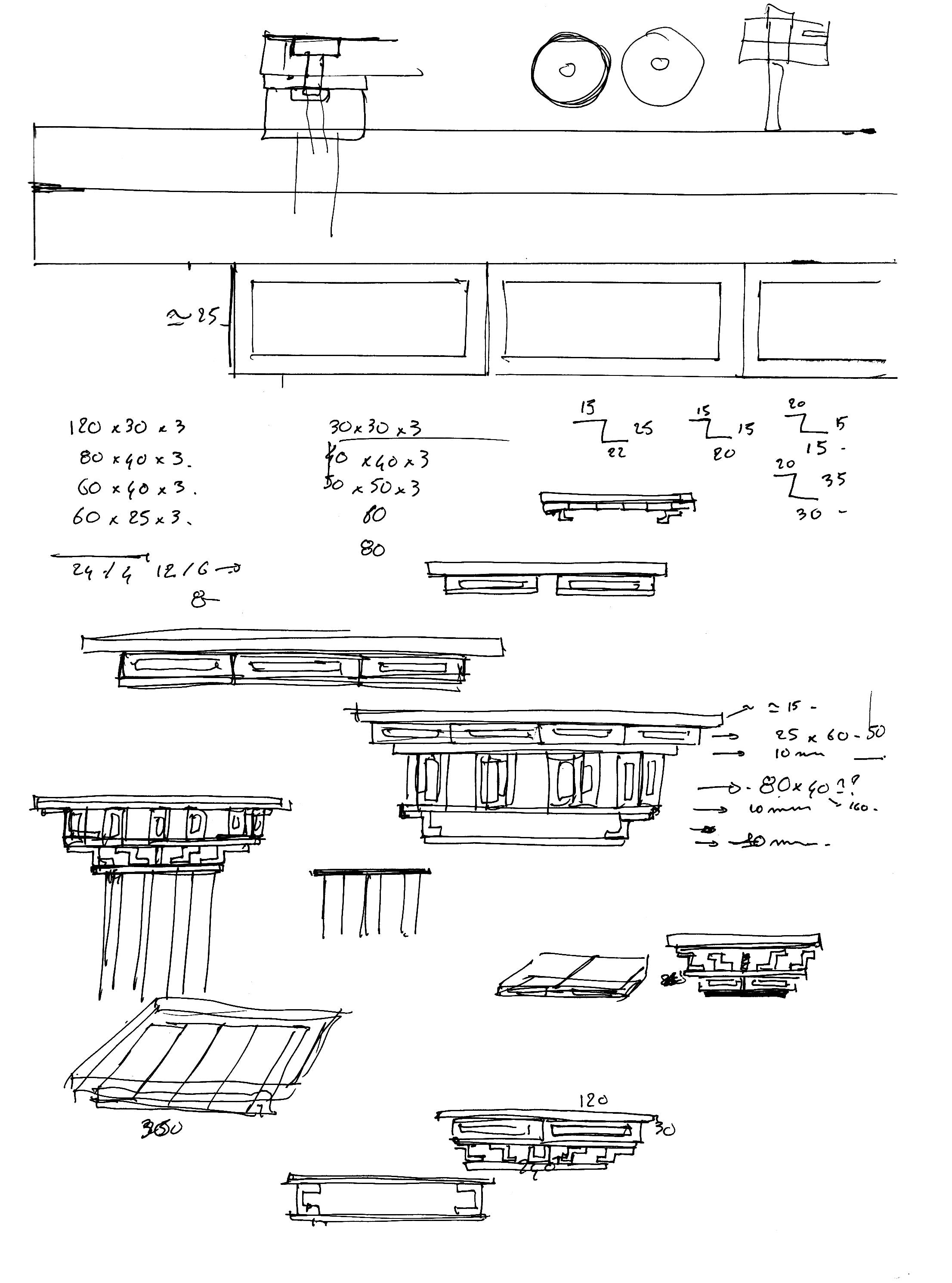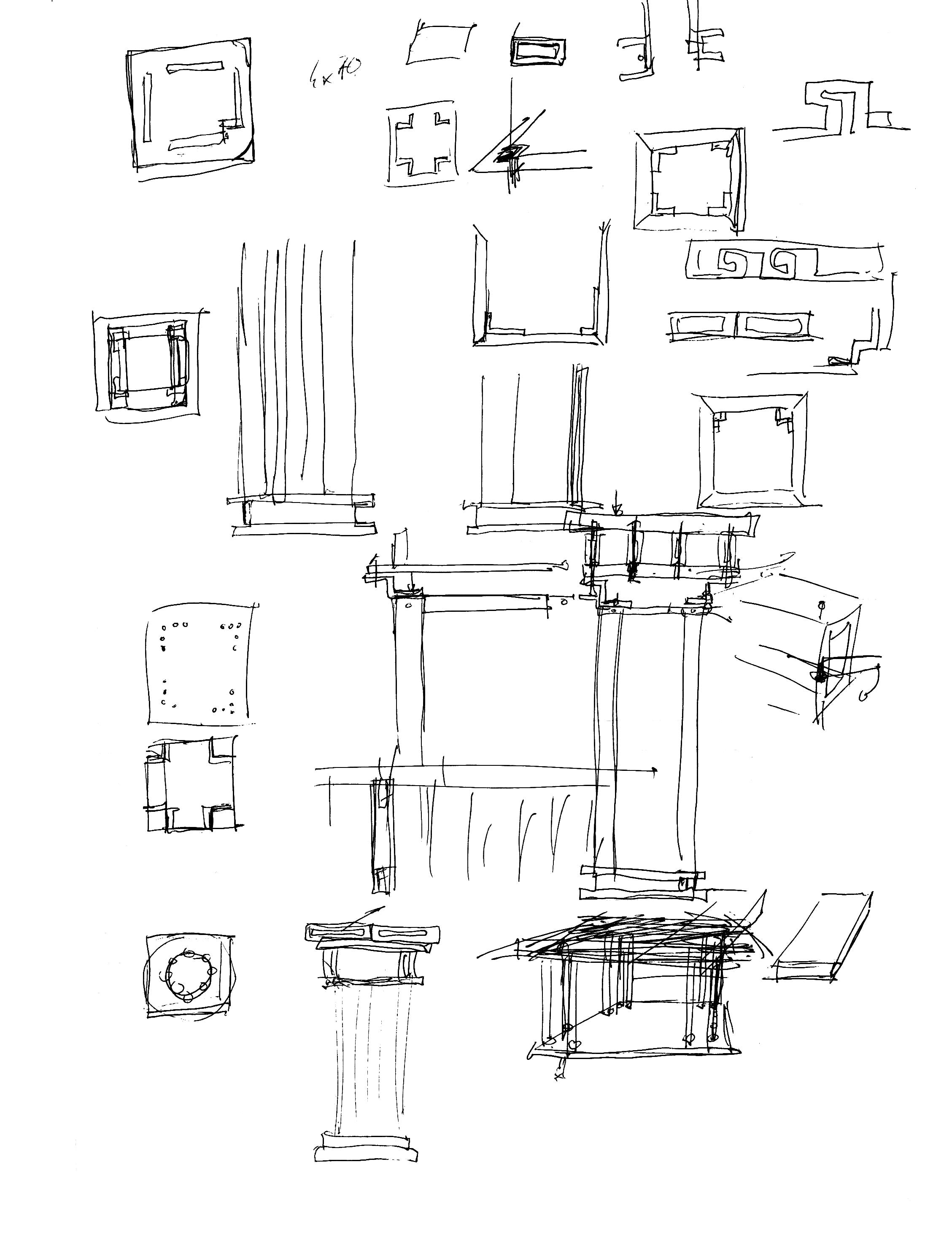
| DEEPEN |
|
In the beginning of March, with the confinement and the global 2020 pandemic situation, we had just finished our last projects and had to postpone some coming exhibitions. Having mainly shown smaller products and research-based concepts as a studio, this unpredictable “free-time” was the opportunity we needed to develop a simple idea we had for a while: a full collection. It was always a thought in the back of our minds, waiting patiently, and it seemed we could finally materialise it. |

|

|
|
When we began developing a first draft of our collection concept, “ARCHETYPES” wasn’t a subject we just chose, but it obviously became the main link between our inspiration sources. It comes from multiple influences: from Carla’s daily confrontation to classical Parisian architectures, to Jordan’s cabinet-making background and passing by the industrial area of Eindhoven in the Netherlands, where we have our workspace. |
« (…) Behind the plurality of the many forms in history lies a simple set of archetypes which we can call the grammar of architecture. These archetypes may be understood as images which can be identified in relation to both architectural
|

|
Our inspiration took place from emblematic edifices such as Pont du Gard (Roman aqueduct, FR) and ruins from the Parco archeologico del Colosseo in Rome. From the observation of the construction and the formalistic essence of these architectures, we translate those archetypes into new furniture pieces. As we linked the ceramic craft with the industry/technology in our project « Moca ». This time, we tried to create a bridge between two time periods in history : Ancient Rome and Industrial era. The translation happen using a modern language of material and process. The use of acrylic, standardised aluminium profiles and laser cut sheets, project the classic sculptural languages into a new industrial aesthetic. It also enhance the temporality of each objects into a longterm construction. While the collection is unified by the use of the same materials and aesthetic, each piece takes its cues from a number of latin or greek sources:
|
|
is a bookcase inspired by Roman aqueducts such as the Pont du Gard in France. We mainly were inspired by the pillars rhythms and interspaces found in the conventional aqueduct architectures. From spacious intervals on the ground-level to smaller ones on the higher ones. The etymology of the word PEGMA can be found in the ancient greek and latin languages: its meaning is “bookcase”. |
is a dining table inspired by the ruins from the temple of Apollo Sosianus in Rome. The three re-erected and existing columns of this temple in Rome were the main inspiration for the legs of the Aedes table. Moreover, its original cornice/frieze became our industrial structure which support the Getacore table top. The etymology of Aedes, comes from the latin word “temple”. |
|
is a light installation which creates an ambiance and gives structure to a public or private space by surrounding it. Arceo is inspired by numerous Roman architectures such as aqueducts, triumphal arches or even the surroundings of the “Canopus” of Hadrian’s Villa in Tivoli. It can be composed of various units : for example an entrance with 4 arches, a triptych with 3 arches or a duo with shelves. One of Arceo’s latin etymology means “to enclose”, which is the aim of this installation. |
(large) is a large fruit display influenced by emblematic roman edifices and their seating such as the Colosseum in Rome or the Arena of Nimes. Clay is the closest material to create a bridge between the past and new industrial aesthetic created in the ARCHETYPES collection. |

|

|
|
are columns that can serve as pedestals to display your favourite objects (or plants). Inspired by different temples structures and column shapes from the Parco archeologico del Colosseo in Rome, made out of industrial aluminium profiles and sheets, these columns create an historical presence in your interior. |
is a Doric architectural element used in temple friezes: it's a space between triglyphs which sometimes is adorned with sculptures. These elements can be found on many temples, such as the Temple of Hephaestus in Athens or on the Athenian Treasury in Delphi, Greece. The top part of the METOPE column is our industrial interpretation of this element. |
|
is a specific type of round temples, which is (sometimes) surrounded by columns. It's an architectural style found in the ancient greek and Roman temples such as the Tholos of Delphi or the temple of Vesta in Roma. We created the main body of THOLOS with ten long aluminium tubes placed in a round shape to translate this temple style into an industrial column. |
is a specific type of colonnade which is placed on the side of most of the Ancient Greek or Roman temples. Our column PTERON has twelve smaller columns, these colonnades facing each others and which support the top, are part of our translation from this style to an industrial style. |
 SHOP — Metope €1320,00 |


